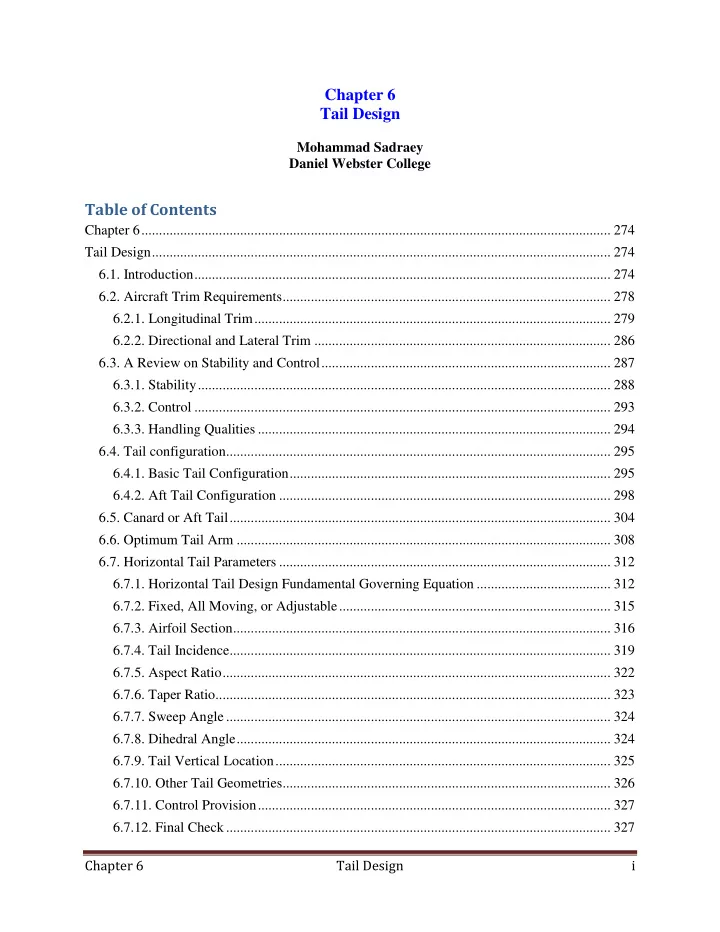

Chapter 6 Tail Design Mohammad Sadraey Daniel Webster College Table of Contents Chapter 6 ..................................................................................................................................... 274 Tail Design .................................................................................................................................. 274 6.1. Introduction ...................................................................................................................... 274 6.2. Aircraft Trim Requirements ............................................................................................. 278 6.2.1. Longitudinal Trim ..................................................................................................... 279 6.2.2. Directional and Lateral Trim .................................................................................... 286 6.3. A Review on Stability and Control .................................................................................. 287 6.3.1. Stability ..................................................................................................................... 288 6.3.2. Control ...................................................................................................................... 293 6.3.3. Handling Qualities .................................................................................................... 294 6.4. Tail configuration............................................................................................................. 295 6.4.1. Basic Tail Configuration ........................................................................................... 295 6.4.2. Aft Tail Configuration .............................................................................................. 298 6.5. Canard or Aft Tail ............................................................................................................ 304 6.6. Optimum Tail Arm .......................................................................................................... 308 6.7. Horizontal Tail Parameters .............................................................................................. 312 6.7.1. Horizontal Tail Design Fundamental Governing Equation ...................................... 312 6.7.2. Fixed, All Moving, or Adjustable ............................................................................. 315 6.7.3. Airfoil Section ........................................................................................................... 316 6.7.4. Tail Incidence............................................................................................................ 319 6.7.5. Aspect Ratio .............................................................................................................. 322 6.7.6. Taper Ratio................................................................................................................ 323 6.7.7. Sweep Angle ............................................................................................................. 324 6.7.8. Dihedral Angle .......................................................................................................... 324 6.7.9. Tail Vertical Location ............................................................................................... 325 6.7.10. Other Tail Geometries............................................................................................. 326 6.7.11. Control Provision .................................................................................................... 327 6.7.12. Final Check ............................................................................................................. 327 Chapter 6 Tail Design i
6.8. Vertical Tail Design ......................................................................................................... 328 6.8.1. Vertical Tail Design Requirements ........................................................................... 328 6.8.2. Vertical Tail Parameters ........................................................................................... 330 6.9. Practical Design Steps...................................................................................................... 340 6.10. Tail Design Example...................................................................................................... 342 Problems ................................................................................................................................. 348 References ............................................................................................................................... 352 Chapter 6 Tail Design ii
C h a p t e r 6 Ch ha ap pt te er r 6 6 C T a i l D e s i g n Ta ai il l D De es si ig gn n T 6.1. Introduction As introduced in chapter 2, the next appropriate step after wing design would be the tail design. In this chapter, after describing the tail primary functions, and introducing fundamentals that govern the tail performance, techniques and procedure to design the horizontal tail and vertical tail will be provided. At the end of the chapter a fully solved example that illustrates the implementation of the design technique will be presented. Horizontal tail and vertical tail (i.e. tails) along with wing are referred to as lifting surfaces. This name differentiates tails and wing from control surfaces namely aileron, elevator, and rudder. Due to this name, several design parameters associated with tails and wing; such as airfoil, planform area, and angle of attack; are similar. Thus, several tails parameters are discussed in brief. The major difference between wing design and tail design originates from the primary function of tail that is different from wing. Primary function of the wing to generate maximum amount of lift, while tail is supposed to use a fraction of its ability to generate lift. If at any instance of a flight mission, tail nears its maximum angle of attack (i.e. tail stall angle); it indicates that there was a mistake in the tail design process. In some texts and references, tail is referred to as empennage. The ail in a conventional aircraft has often two components of horizontal tail and vertical tail and carries two primary functions: 1. Trim (longitudinal and directional) 2. Stability (longitudinal and directional) Since two conventional control surfaces (i.e. elevator and rudder) are indeed parts of the tails to implement control, it is proper to add the following item as the third function of tails: 3. Control (longitudinal and directional) These three functions are described in brief here; however, more details are presented in later sections. The first and primary function of horizontal tail is longitudinal trim; also referred Chapter 6 Tail Design 274
Recommend
More recommend